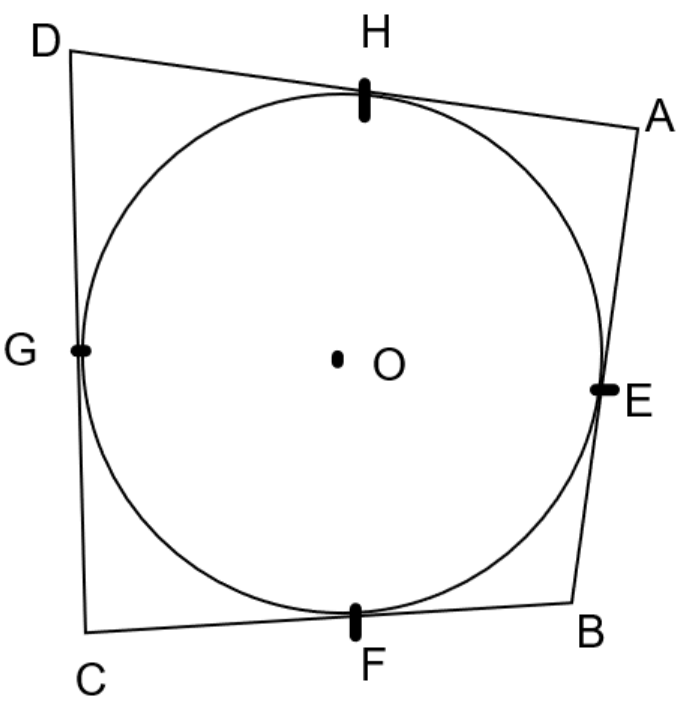
If the sides of a quadrilateral touch a circle, prove that the sum of opposite sides is equal to the sum of the other pairs.


Answer
406.2k+ views
Hint: We have to show that the sum of opposite sides of the quadrilateral which touches a circle is equal to the sum of the other pair of sides. We solve this question using the properties of tangents. First we will show a relation for all the tangents which will be formed and then we will substitute the values of the relations of the tangents such that on adding the tangents we get the relation that the sum of opposite sides of the quadrilateral are equal to the other pair.
Complete step-by-step solution:
Given :
To prove :
Proof :
We know that the property of tangents of a circle states that the tangents drawn from the same external points onto the point on the circle are always equal in length.
So, we can state that using the above stated property of tangents that :
[Tangents originated from the same external point
[Tangents originated from the same external point
[Tangents originated from the same external point
[Tangents originated from the same external point
Now, we will add the equation
On adding the equations, we get
Now, we also know that the sides of the quadrilateral can be written as :
similarly, for the other pair
Using the above sum of the sides of quadrilateral, we can write the equation
Hence proved that the sum of opposite sides is equal to the sum of the other pairs.
Note: We should take care of the relations of the tangents while adding the equation to obtain the relation for the sides of the quadrilateral. As if we reverse any one of the relation of the equation
If we add the relation of the tangents as :
We will get the sum of the four equations as :
From this expression we won’t be able to prove the statement.
Complete step-by-step solution:
Given :
To prove :
Proof :
We know that the property of tangents of a circle states that the tangents drawn from the same external points onto the point on the circle are always equal in length.
So, we can state that using the above stated property of tangents that :
[Tangents originated from the same external point
[Tangents originated from the same external point
[Tangents originated from the same external point
[Tangents originated from the same external point
Now, we will add the equation
On adding the equations, we get
Now, we also know that the sides of the quadrilateral can be written as :
similarly, for the other pair
Using the above sum of the sides of quadrilateral, we can write the equation
Hence proved that the sum of opposite sides is equal to the sum of the other pairs.
Note: We should take care of the relations of the tangents while adding the equation to obtain the relation for the sides of the quadrilateral. As if we reverse any one of the relation of the equation
If we add the relation of the tangents as :
We will get the sum of the four equations as :
From this expression we won’t be able to prove the statement.
Recently Updated Pages
Master Class 9 General Knowledge: Engaging Questions & Answers for Success

Master Class 9 English: Engaging Questions & Answers for Success

Master Class 9 Science: Engaging Questions & Answers for Success

Master Class 9 Social Science: Engaging Questions & Answers for Success

Master Class 9 Maths: Engaging Questions & Answers for Success

Class 9 Question and Answer - Your Ultimate Solutions Guide

Trending doubts
Fill the blanks with the suitable prepositions 1 The class 9 english CBSE

Difference Between Plant Cell and Animal Cell

Given that HCF 306 657 9 find the LCM 306 657 class 9 maths CBSE

The highest mountain peak in India is A Kanchenjunga class 9 social science CBSE

What is the difference between Atleast and Atmost in class 9 maths CBSE

What is pollution? How many types of pollution? Define it




